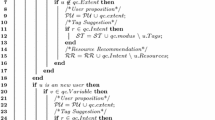Abstract
This paper proposes a recommendation method that focuses on not only predictive accuracy but also serendipity. On many of the conventional recommendation methods, items are categorized according to their attributes (a genre, an authors, etc.) by the recommender in advance, and recommendation is made using the results of the categorization. In this study, impressions of users to items are adopted as a feature of the items, and each item is categorized according to the feature. Impressions used in such categorization are prepared using folksonomy, which classifies items using tags given by users. Next, the idea of “concepts” was introduced to avoid synonym and polysemy problems of tags. “Concepts” are impressions of users on items inferred from attached tags of folksonomy. The inferring method was also devised. A recommender system based on the method was developed in java language, and the effectiveness of the proposed method was verified through recommender experiments.





Similar content being viewed by others
References
Kamishima T (2007) Algorithms for recommender systems (1) (in Japanese). J JSAI 22(6):826–837
Ziegler C, McNee SM, Konstan JA, Lausen G (2005) Improving recommendation lists through topic diversification. In: Proceedings of the 14th international conference on World Wide Web, pp 22–32
Oku K, Hattori F (2013) Fusion-based recommender system for serendipity-oriented recommendations (In Japanese). JSOFT J 25(1):542–539
Pauws S, Verhaegh W, Vossen M (2006) Fast generation of optimal music playlists using local search. In: Proceedings of the 7th international conference on music information retrieval, pp 138–143
Sumimoto S, Nakagawa H, Tahara Y, Ohsuga A (2011) A recommender agent providing novelty and serendipity on social media SNS (In Japanese). IEICE Trans Inf Syst 194-D(11):1800–1811
Murakami T, Mori K, Orihara R (2008) Metrics for evaluating the serendipity of recommendation (In Japanese). New Frontiers Artif Intell Lect Notes Comput Sci 4914:40–46
Sato F, Otaki A, Hattori H, Sato H, Takadama K (2010) Serendipity-based recommender system: maintaining the users interest in the search by recommending the items in other categories (In Japanese). In: Proceedings of the 24th Annual Conference of JSAI 3C3-3, pp 1–4
Herlocker J, Konstan JA, Terveen LG, Riedl JT (2004) Evaluating collaborative filtering recommender system. ACM Trans Inf Syst 22(1):5–53
Chan P.K (1999) A non-invasive learning approach to building web user profiles. KDD.99 Workshop on Web Usage Analysis and User Profiling, pp 7–12
Niwa S, Doi T, Honiden S (2006) Web page recommender system based on Folksonomy Mining (in Japanese). IPSJ J 47(5):1382–1392
Author information
Authors and Affiliations
Corresponding author
Additional information
This work was presented in part at the 18th International Symposium on Artificial Life and Robotics, Daejeon, Korea, January 30–February 1, 2013.
About this article
Cite this article
Yamaba, H., Tanoue, M., Takatsuka, K. et al. On a serendipity-oriented recommender system based on folksonomy. Artif Life Robotics 18, 89–94 (2013). https://doi.org/10.1007/s10015-013-0103-3
Received:
Accepted:
Published:
Issue Date:
DOI: https://doi.org/10.1007/s10015-013-0103-3




